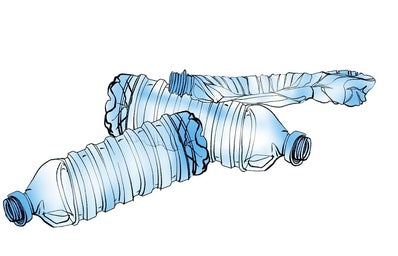For each year of school I can think of the water bottle that could be considered “trendy”. My first memory of this is from third or fourth grade when the coolest object you could have sitting on the top corner of your desk was a Camelbak water bottle. Specifically the one with the clear squishy mouthpiece and that came in a variety of transparent colors. Mine had a gray straw cap and a transparent powder blue body with a pale blue diamond pattern. Even though it was just a water bottle, no more than a slightly elevated plastic container, bringing it to school everyday was a way to demonstrate to my peers that I was keeping up with the trends.
In middle school it was S’well water bottles that sat in the lockers which lined the hallways of my school. They were narrow, tall, made of stainless steel, and had a concerningly weird smell that never went away no matter how many trips through the dishwasher it took. I remember teachers discouraging us from bringing them into the classroom because they lacked a handle and therefore were often dropped. The ear splitting, alarming sound that reverberated off the walls when the bottle so much as tipped over was enough to drive someone insane.
Then it was Hydro Flasks that dominated my high school. Specifically the 32 ounce bottle with a straw lid was the absolute most trendy bottle someone could possibly have for a while. In an attempt to demonstrate some sense of individuality, people would customize their bottles by painting them or looping elaborate friendship bracelets around the handle. I am part of the group of Hydro Flask users who have their bottle covered in a borderline ridiculous amount of stickers. Similarly to S’Well bottles, these make an insufferable noise when dropped and constantly have a peculiar odor.
Now at Denison I see a wider variety of water bottles being carried around campus by my peers (likely a testament to the fact that we all have better and more important things to focus on than the brand of our water bottle). The Stanley Cup Tumbler seems to be a current favorite as well as the Owala FreeSip. Nalgene water bottles are also a classic if you want people to know that you willingly go camping and enjoy long hikes. However some of us, myself included, are still carrying around our Hydro Flasks that have been through it all and have the dents to show for it. Mine turned four years old this month and could probably be classified as my “emotional support water bottle”. But why does it even matter? Why do I remember the different water bottles everyone was carrying around each year in the same way I remember which styles of clothing were trendy?

Our society has uniquely shifted water bottles from being a purely practical container, into an accessory. They have a unique universal appeal because of a simple fact: everyone needs to drink water. It is not provocative for a man to have a trendy water bottle in the way it may be for him to wear stylish jewelry or other accessories that are perceived to be feminine. Similarly, a woman having a trendy water bottle is not seen as a “frivolous” expense in the way flashy shoes or a designer bag may be. A water bottle is truly an accessory that is considered socially acceptable for all genders to carry.
The rise of reusable water bottles also speaks to the interest consumers have in sustainability movements. Reusable water bottles serve as an environmentally friendly alternative to single use plastic water bottles. Simply owning and regularly using a reusable water bottle, regardless of the brand or style, is an indicator that you as a consumer support some level of sustainability. Additionally, sustainability movements could be considered an “on trend” movement to support due to the emphasis on support for change initiatives, or depending on the politician the opposition to climate change initiatives, seen in politics.
The brand of the water bottle can also fit into a specific aesthetic that someone may be trying to curate. Keep in mind these are all extreme generalizations, but a Stanley Cup water bottle can be associated with preppy girls in sororities. As I mentioned earlier, Nalgene bottles are often indicators of someone’s love for nature and outdoor activities. Hydro Flasks used to be paired with colorful velvet scrunchies and carried around by “VSCO girls”. Even plastic Gatorade water bottles, the ones with the neon orange cap and deep green body, I will always associate with the guys in high school who were three-sport varsity athletes. People choose their water bottles depending on their interests and the type of person they want society to view them as. Our choices, even the ones as small as the water bottle we carry, are made in response to our environment.


